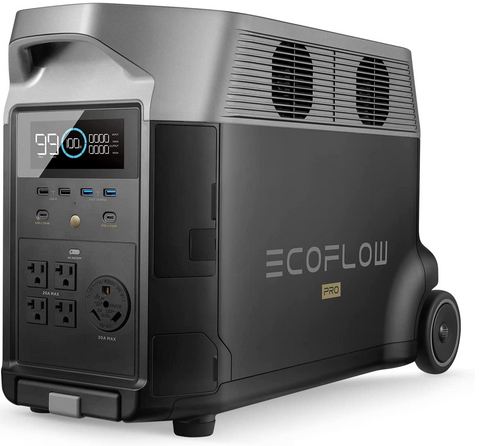Shopping for a high capacity and high output solar generator for home backup or off-grid power?
I recommend the EcoFlow Delta Pro. With a capacity of 3.6kWh and an output of 3.6kW, it is currently the largest power station EcoFlow sells.
It’s ideal for home backup during power emergencies. You can also pair it with solar panels or the EcoFlow smart generator to provide off-grid power in an RV, boat or cabin.
Read on for my in-depth review of the EcoFlow Delta Pro, including what I like and don't like about it.
I also compare the Delta Pro against three alternatives.
If the Delta Pro is not what you are looking for, see other high-capacity picks in my home backup solar generator buying guide.
And if you are looking for a smaller unit that’s more portable, see my reviews of the best portable solar generators.
EcoFlow Delta Pro Pros & Cons
Pros
Cons
Best Features
1. Massive 3.6 kWh Expandable Capacity
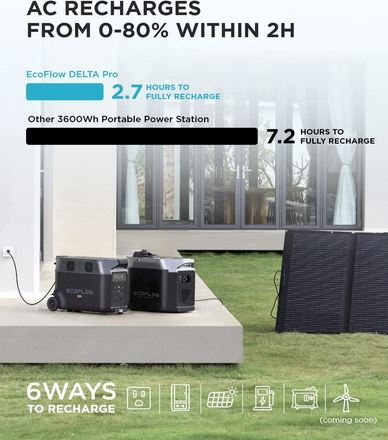
The EcoFlow Delta Pro is one of the largest solar generators in the market. The 3600Wh battery is capable of supporting multiple appliances.
This makes the Delta Pro a great pick for home backup. You can keep your fridge, TV, microwave and other appliances running for a day or two in case of a blackout.
The Delta Pro is also great for off-grid power in RVs, motorhomes, boats and cabins.
If you need more capacity, the Delta Pro is expandable. By connecting EcoFlow smart batteries, you can increase capacity up to 25kWh. That’s enough for several days of emergency power.
Another thing we like about the battery in the Delta Pro is that it’s lithium-phosphate, not lithium ion like in most other EcoFlow power stations.
The LiFePO4 battery lasts a long time — 3500 cycles to 80% capacity and 6500 cycles to 50% capacity. With good care, you’ll be using the Delta Pro power station for 10 years or more.
In contrast, Li-ion power stations last about 5 years.
What can the EcoFlow Delta Pro power?
Appliance/device | Run time/recharges |
CPAP (40W) | 50hrs |
Fridge (120W) | 24hrs |
Microwave (1300W) | 2.5hrs |
Smartphone (11Wh) | 313 recharges |
Laptop (60Wh) | 57 recharges |
Coffee maker (1000W) | 3.3hrs |
50” TV (110W) | 27hrs |
2. 3600W Output
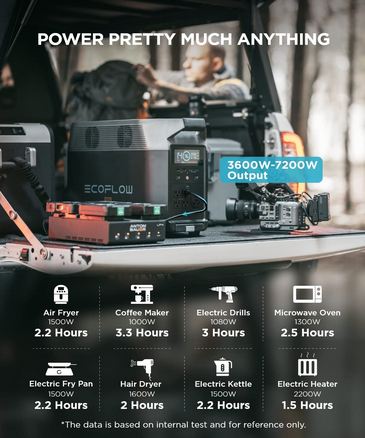
In terms of output, the EcoFlow Delta Pro is also one of the most powerful solar power stations in the market.
It has a continuous AC output of 3600W. That’s not all.
The Delta Pro comes with EcoFlow’s X-Boost function. When you turn it on, the Delta Pro can support a load of up to 4500W. That’s still not all.
If you get a second Delta Pro and an EcoFlow double voltage hub, you can get up to 7200W of 240V power.
That’s enough power to run several circuits in your home or power an entire cabin or RV.
The double voltage hub also makes it easy to run 240V electronics like some air conditioners, heavy-duty power tools, and water heating systems.
So whether you need to power a single large appliance, several appliances or an entire small home, the EcoFlow Delta Pro has you covered.
3. Home Integration
To take advantage of the high capacity and output, EcoFlow makes it easy to connect the Delta Pro directly to your home wiring.
This allows you to power appliances right where they are.
You’ll need the EcoFlow smart home panel to integrate the Delta Pro into your home grid. It lets you connect the Delta Pro to 10 circuits.
The panel will automatically (within 20ms) switch to backup power when grid power goes down.
You can add solar panels and extra batteries to your setup to complete your home backup system. If you want to run as many appliances as possible, also consider getting a second Delta Pro to achieve an output of 7200W.
Note: Home integration can only be done by a certified electrician.
4. Multiple Outlets
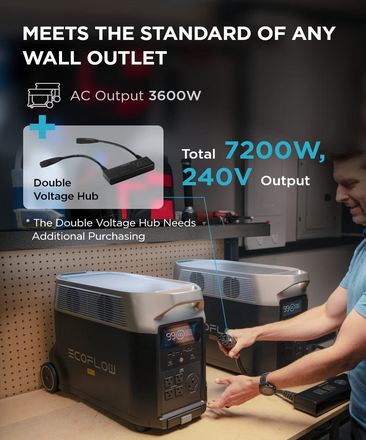
If you prefer using the Delta Pro the old fashioned way, it comes with multiple outlets.
5. Five Ways To Recharge
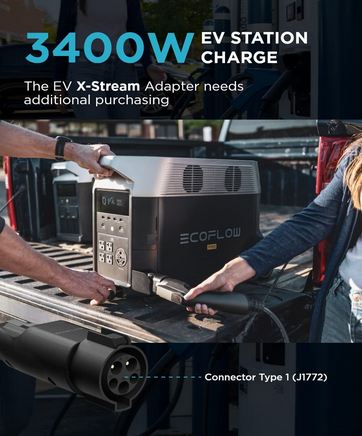
The Delta Pro also comes with a wide range of input options. Like other EcoFlow models, most of these provide blazing fast charging.
The most common way to recharge the Delta Pro is by plugging the included 1800W charger into a standard AC outlet. This charges it to 80% in just 2.7 hours.
Considering the massive size of the battery, that’s crazy fast. I have reviewed much smaller solar generators that take twice as long to recharge.
You can also charge the Delta Pro from solar. It accepts up to 1500W solar power (11-150V). A solar array of this size will recharge the Delta Pro in 2.8-5.6 hours.
If there’s no sunshine or you don't have solar panels, you can also charge the Delta Pro from the EcoFlow smart generator, a gas/propane generator. It’ll recharge the Delta Pro in about the same time as an AC outlet.
Another charging option in an emergency or when you are on the road is an EV charging station. That’s right, you can recharge the Delta Pro from any level 2 EV charging station.
You’ll need to order the X-Stream adapter, which inputs 3400W of power to charge the Delta Pro in just 1.7 hours.
If you’ve installed a level 2 EV charger in your home, that will also work.
Though slower, you can also charge the Delta Pro from your vehicle’s 12V/24V outlet.
The fifth way to recharge the Delta Pro is by combining AC, solar and the smart generator. That will provide 6500W of charging power, though you’ll need the EcoFlow smart extra battery to use this option.Three Ways To Monitor
You have three ways to control and monitor the EcoFlow Delta Pro.
You can use the display on the power station. It shows you all the info you need and has all the customization settings.
If you cannot access the power station easily (e.g. because it’s in the garage or below deck), get the Delta Pro remote control and connect it to the power station via ethernet or Bluetooth. You can then place the remote control screen where it’s easy to access.
The third option is the EcoFlow app. The app offers even more customization options and lets you monitor everything about the Delta Pro wherever you are.
Issues & Limitations
Heavy
If you are looking for a portable solar generator, the EcoFlow Delta Pro is not it. Yeah, it’s portable but not in the sense that you can take it with you camping or to a tailgating party.
It weighs 99lbs and it’s huge.
At least it comes with a handle and wheels, so you can move it around your home.
No Outlets On Expansion Batteries
Unlike the expansion battery packs Bluetti sells for their power stations, the extra batteries for the Delta Pro have no outlets at all.
The lack of AC outlets on the batteries is understandable since it would require equipping them with inverters. But USB and DC outlets would have been handy for connecting extra devices and electronics.
Alternatives To The EcoFlow Delta Pro
Still not sure about getting the Delta Pro? Here are three alternatives to consider.
1. Renogy Lycan 5000 - Rugged Off-grid Power Station
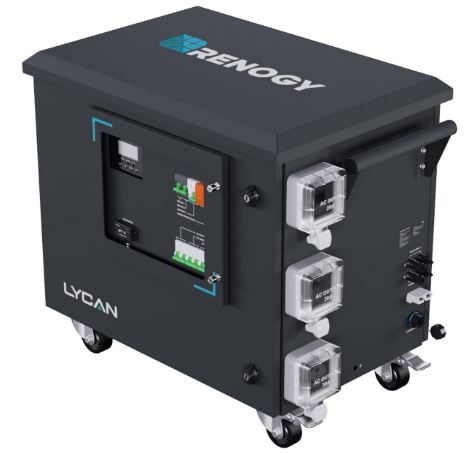
If you are shopping for a solar generator specifically for off-grid power, the Renogy Lycan 5000 is a better pick.
It’s designed primarily for off-grid and emergency use. It even comes with a waterproof housing for better protection.
The housing has a door at the front and back where you can access switches, breakers, and even the batteries.
The Renogy Lycan 5000 has a capacity of 4.8kWh, more than the EcoFlow Delta Pro. Of course, it’s expandable.
You can add more Renogy 48V 50Ah LiFePO4 batteries to expand capacity up to 19.2kWh.
The Lycan 5000 already comes with an inverter charger integrated. It delivers up to 3500W of continuous AC power. It also charges the batteries when you plug the power station into an AC outlet.
The Renogy Lycan 5000 comes with just two AC outlets - a 20A outlet and a 30A outlet. It doesn't have any other outlets.
It’s designed to be integrated into a home circuit rather than being used as a standalone power station. You can recharge it via solar (up to 4400W input) and AC, or both at the same time to speed up charging.
Have an electrician connect the Lycan 5000 to your home fuse box. If you are using it for emergency backup power, you’ll need to buy an automatic or manual transfer switch and wire it to the fuse box and the power station.
Note that the Renogy Lycan 5000 is heavy, very heavy. It weighs 264lbs. It comes with wheels, so you can position it where it’s most convenient. But I don't recommend moving it too often.
2. Goal Zero Yeti 6000X - More Capacity
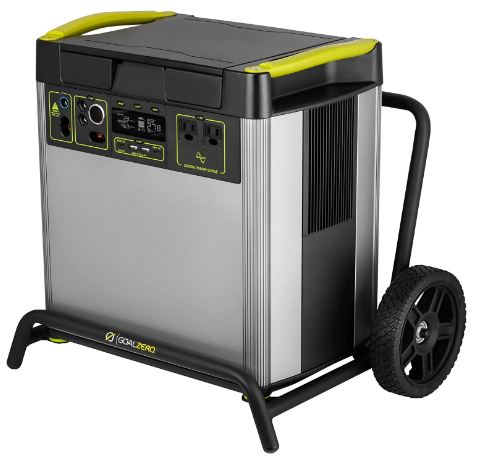
If you need more capacity without getting extra batteries, I recommend the Goal Zero Yeti 6000X.
It has a capacity of 6071Wh, a lot more than what the Delta Pro offers before you expand it. The Yeti 6000X is a great pick if you need a high-capacity solar generator that can fit in a fairly small space.
Where the Yeti 6000X falls short is power output. It has an output of 2000W, less than what we’d expect from a power station of this size.
While it can power most household appliances, you cannot run too many appliances at once.
This is especially limiting if you plan to integrate the Goal Zero into your home circuit using the Yeti home integration kit. 2000W doesn't let you power more than a few circuits. In fact, the kit is limited to four circuits only.
Another downside of the Yeti 6000X is that it uses a Li-ion battery, not lithium-phosphate like most large power stations. Li-ion batteries typically last half as long as LiFePO4.
Considering you are spending thousands of dollars on the power station, its limited lifespan is a concern.
3. EcoFlow Delta Max - Lighter & Smaller
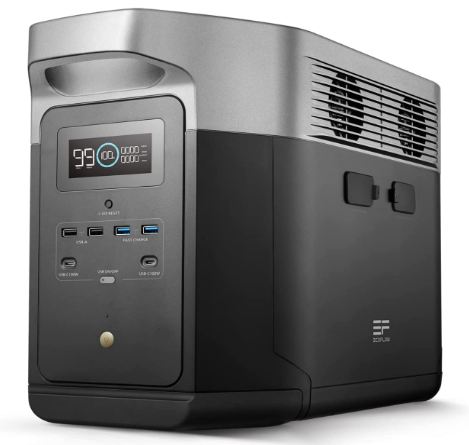
If you are looking for a smaller and lighter, but still capable power station, go with the EcoFlow Delta Max. It’s the smaller sibling to the Delta Pro.
The Delta Max has a 2016Wh Li-ion battery and a continuous output of 2400W, which you can increase to 3400W with X-Boost.
The Delta Max not only has the capability to power large appliances, it can run multiple appliances at the same time.
The smaller battery drains faster, but Delta Max comes with X-Stream charging that refills it in less than two hours.
If you want more capacity, the Delta Max is expandable to 6048Wh.
The Delta Max power station weighs 48lbs. While not exactly lightweight, it’s light enough for use in RVs, trucks, motorhomes, camper vans and car camping.
Care and Maintenance
Lithium power stations generally don't need any maintenance. All you need to do is take care of it by keeping it in cool temperatures and avoiding exposure to moisture, heat and the elements.
If you plan to store it for a long time, make sure it is charged before storage. Then recharge it every three months to keep it from fully discharging.
Warranty
EcoFlow offers a 2-year warranty on the Delta Pro with a 3-year extension if you register it with them.
Specifications | |
|---|---|
Weight: | 99lbs |
Size: | 150W output at 60Hz |
Capacity: | 3600Wh |
AC output: | 3600W continuous (5000W surge), 4500W with X-Boost, 7200W with double voltage hub |
Outlets: | 5xAC, 1x30A Anderson, 2xUSB-A, 2xQC USB-A, 2x100W USB-C, 3x12V DC |
Max solar input: | 1500W |
Charging time: | 2.7hrs with AC adapter, 2.8-5.6 hours with 800W solar |
Battery chemistry: | Lithium phosphate |
Battery lifespan: | 3500 cycles to 80% |
Operating temperature: | 68°F to 86°F (optimal), 14°F to 113°F (discharge), 32°F to 113°F (charge) |
Where To Buy?
You can order the EcoFlow Delta Pro, plus accessories like extra batteries and the smart home panel, on the official EcoFlow website.
The Delta Pro is also available on Amazon.

